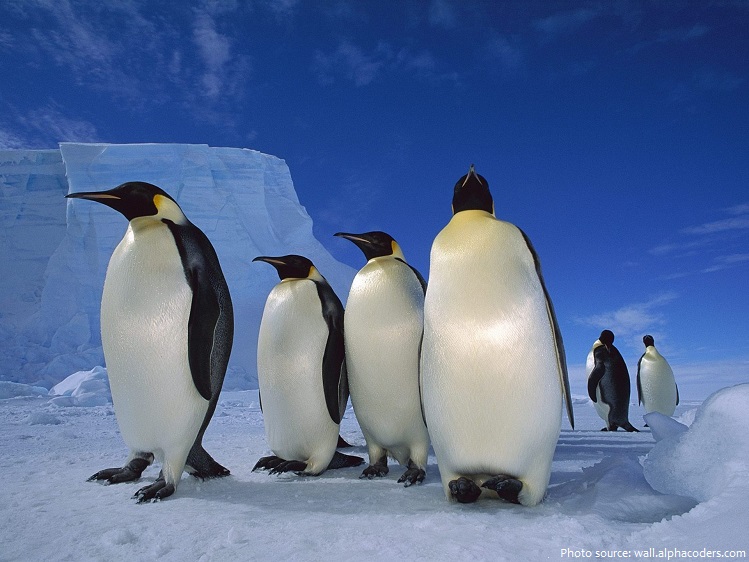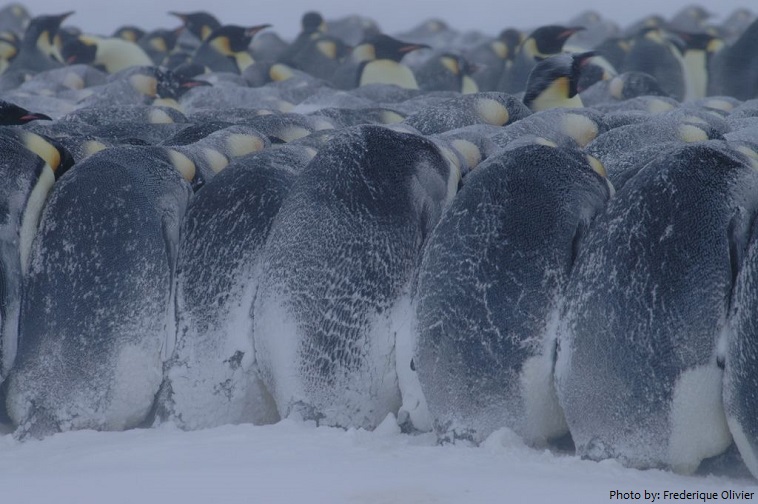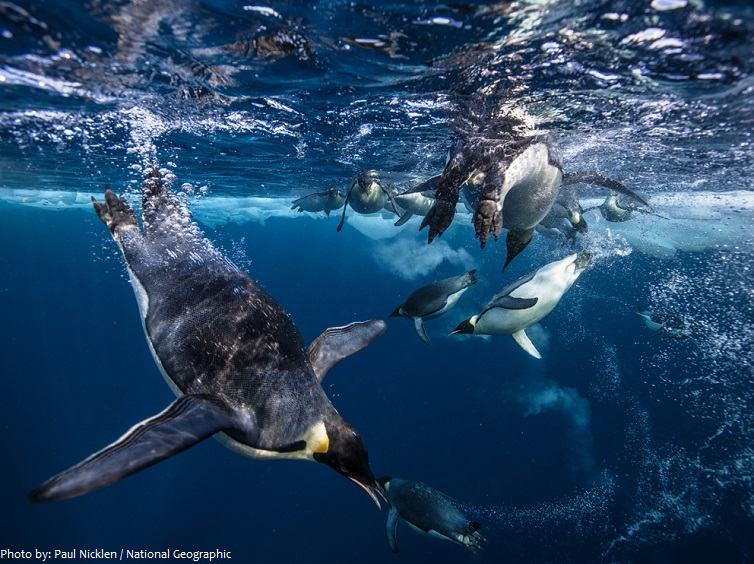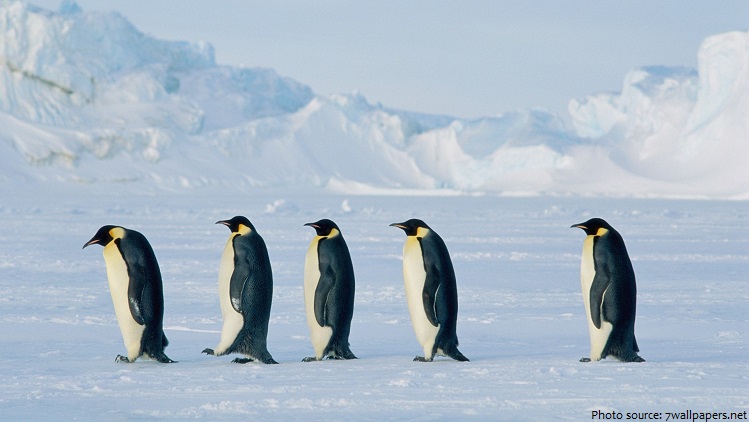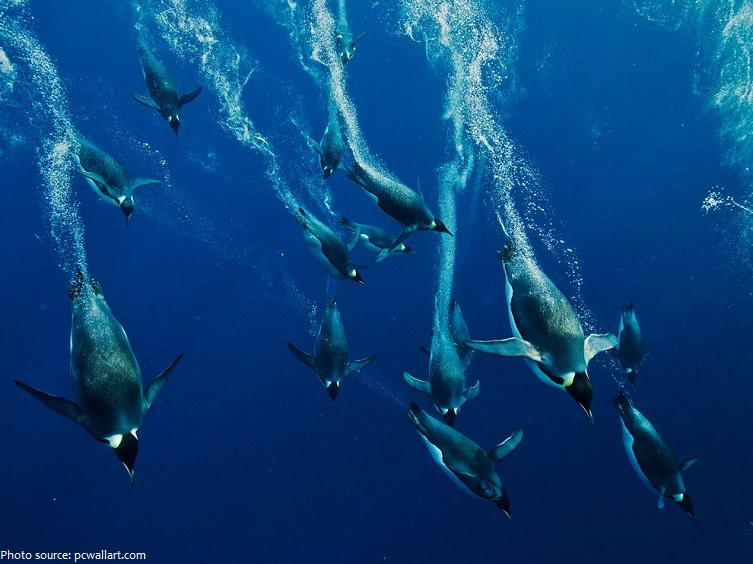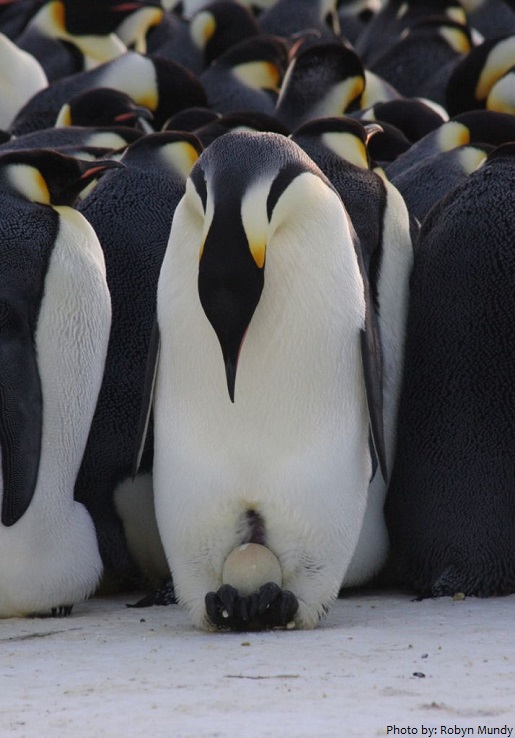The emperor penguin (Aptenodytes forsteri) is the largest species of penguins.
Emperor penguins spend their entire lives on Antarctic ice and in its waters.
It is the only animal to inhabit the open ice of Antarctica during the winter.
They face wind chills as cold as -60°C (-76°F) and blizzards of 200 km/h (124 mph).
The lifespan is typically 20 years in the wild, although observations suggest that some individuals may live to 50 years of age.
The male and female are similar in plumage and size, reaching 1.1 – 1.3 meters (43–51 in) in height and weighing from 22 to 45 kilograms (49 to 99 pounds).
The dorsal side and head are black and sharply delineated from the white belly, pale-yellow breast and bright-yellow ear patches.
Emperor penguins have special adaptations to survive low temperatures of Antarctica – they have large stores of insulating body fat and several layers of scale-like feathers that protect them from icy winds. They also huddle close together in large groups to keep themselves, and each other, warm.
In severe winter the penguins stay together in a group and form a circle for their protection. The ones in the middle, the warmer area, switch places with the ones in the edge …and they keep doing this on and on.
The species gathers together into approximately 45 colonies that settle on ice shelves and landfast ice along the coastline of Antarctica.
Colonies range in size from a few hundred to over 20 000 pairs.
Like all penguins it is flightless, with a streamlined body, and wings stiffened and flattened into flippers for a marine habitat.
At sea, emperor penguins glide through the water with great speed and agility. Their aerodynamic bodies and strong flippers make them excellent swimmers, reaching speeds up to 19 km/h (12 mph).
They can dive to a depth of 565 meters (1,870 feet) – deeper than any other bird – and hold their breath for for more than 20 minutes.
On land, the emperor penguin alternates between walking with a wobbling gait and tobogganing—sliding over the ice on its belly, propelled by its feet and wing-like flippers.
The emperor penguin’s typical diet consists of fish, krill, squid and crustaceans, though the actual composition of their diet varies from population to population. Fish is the most important food source for emperor penguins, with the Antarctic silverfish accounting for most of the penguin’s diet.
The emperor penguin’s dark plumage fades to brown from November until February (the Antarctic summer), before the yearly moult in January and February. Moulting is rapid in this species compared with other birds, taking only around 34 days.
The emperor penguin’s black and white plumage serves as camouflage while swimming. The black plumage on their back is hard to see from above, while the white plumage on their front looks like the sun reflecting off the surface of the water when seen from below.
Emperor penguins primarily communicate vocally, but they also communicate through body language and posturing. They all look virtually identical, which makes individual recognition very difficult. To overcome this, emperor penguins have evolved different sounding voices and the ability to recognize the individual voices of their mates or chicks. This allows the birds to recognize and find their important conspecifics amid the masses, which all look the same.
Emperor penguins breed in the winter. After a courtship of several weeks, a female emperor penguin lays one single egg then leaves! Each penguin egg’s father balances it on his feet and covers it with his brood pouch, a very warm layer of feathered skin designed to keep the egg cozy. There the males stand, for about 65 days, through icy temperatures, cruel winds, and blinding storms; during this time they will lose about 40% of their body weight.
When female penguins return to the breeding site, they bring a belly full of food that they regurgitate for the newly hatched chicks. Meanwhile, their duty done, male emperors take to the sea in search of food for themselves.
As the youngsters grow, the parents leave them in groups, called ‘crèches’, whilst they head to the ocean to fish. Come December, the warmer temperatures break up the ice that the penguins occupy, bringing open waters closer to the nesting site. By this time, the chicks are old enough to swim and fish, and take to the ocean themselves!
Although emperor penguins are effective hunters, they are also prey to a few Antarctic animals as well. Only a third of the juvenile penguins will make it to their first birthday, falling prey to seabirds like giant petrels or skuas. In the water, both juveniles and adults are eaten by leopard seals and killer whales.
The first breeding colony wasn’t discovered until 1902 by Lt. Reginald Skelton on Scott’s 1901-04 Discovery Expedition some 130 years after the birds had first been seen on Captain Cook’s second voyage.
In 2012 the emperor penguin was uplisted from a species of least concern to near threatened by the IUCN.
A Woods Hole Oceanographic Institution study in January 2009 found that emperor penguins could be pushed to the brink of extinction by the year 2100 due to global climate change.
UK, US and Australian scientists used satellite technology to trace and count the iconic birds, finding them to number almost 600,000.
The computer-animated movie Happy Feet (2006) features emperor penguins as its primary characters, with one in particular that loves to dance; although a comedy, it too depicts their life cycle and promotes an underlying serious environmental message of threats from global warming and depletion of food sources by overfishing.
